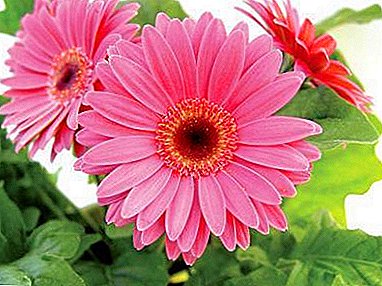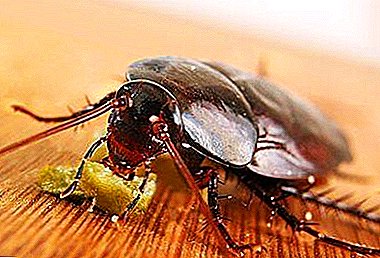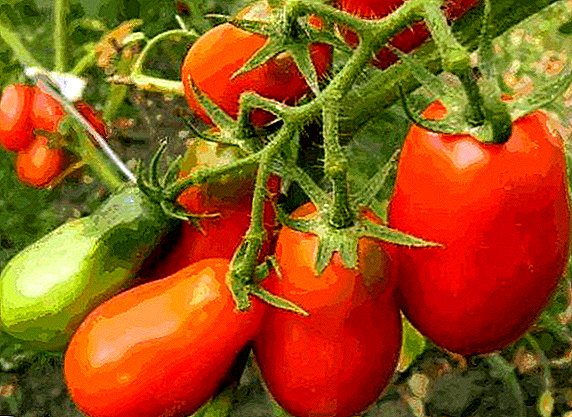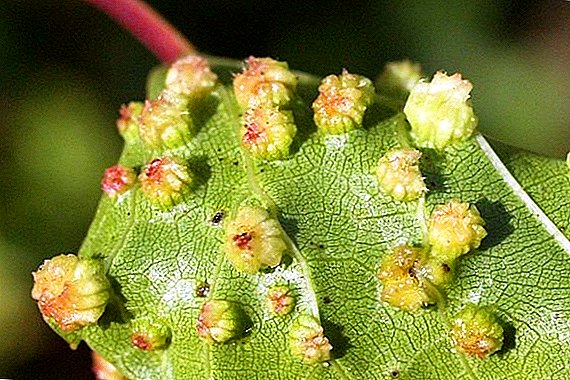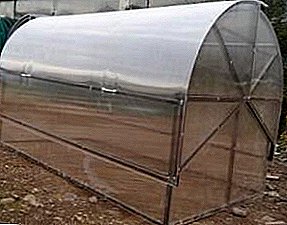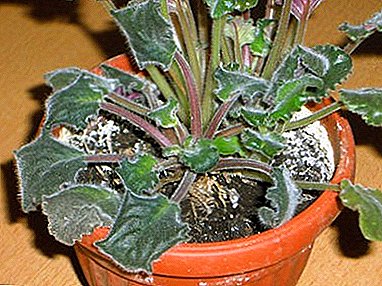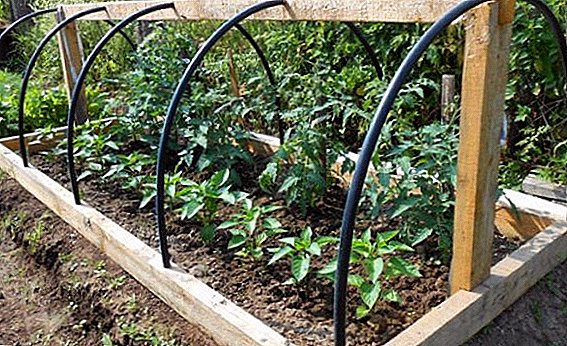 Today, many gardeners and gardeners are convinced of the convenience and ease of use of greenhouses. Seedlings grown in such small greenhouses, shows good results in germination, grows and develops better. In addition, the plants are better adapted to the composition of the soil, hardened. In this article we will discuss the arcs that serve as the basis of the design: what materials can be used and how to build a mini-greenhouse from what is at hand.
Today, many gardeners and gardeners are convinced of the convenience and ease of use of greenhouses. Seedlings grown in such small greenhouses, shows good results in germination, grows and develops better. In addition, the plants are better adapted to the composition of the soil, hardened. In this article we will discuss the arcs that serve as the basis of the design: what materials can be used and how to build a mini-greenhouse from what is at hand.
Basic design requirements
The market is replete with various designs. However, is it worth overpaying for products that are easy to do with your own hands?  Consider the methods of making greenhouses from arcs with a covering material. Greenhouse focused on seasonal use. It should provide all the functions and needs of crops. Consequently, the main requirements for the design, in particular, the frame, of this structure must be:
Consider the methods of making greenhouses from arcs with a covering material. Greenhouse focused on seasonal use. It should provide all the functions and needs of crops. Consequently, the main requirements for the design, in particular, the frame, of this structure must be:
- lightness of materials;
- strength;
- ease of maintenance.
Did you know? The largest greenhouse today is in the UK. In it you can see more than a thousand species of various plants: and tropical (coffee, banana palms, bamboo, etc.), and Mediterranean (olives, grapes, and many others).Arcs under the greenhouse in shape can be not only round and oval, but also rectangular, triangular. According to the materials from which to make the arc for the greenhouse, they are divided into plastic, metal, wood.
Each of the above options when choosing the type and material of manufacturing arcs has its advantages and disadvantages, which will be discussed below. The main condition should be the price and expediency of application.  In the manufacture of a greenhouse should take into account the fact that it must be aired. The accumulation of excessive moisture can lead to the development of harmful bacteria that cause plant diseases. The same applies to the heated greenhouse. Excess heat should be removed.
In the manufacture of a greenhouse should take into account the fact that it must be aired. The accumulation of excessive moisture can lead to the development of harmful bacteria that cause plant diseases. The same applies to the heated greenhouse. Excess heat should be removed.
It is important for professional summer residents to know how to build a greenhouse with their own hands and choose a covering material for the beds.In the manufacture of mini-greenhouses, it is recommended that its height was equal to two-thirds of the width. Recommended sizes of greenhouses (height (Н), width (В), length (L), cm):
- oval or round shape: 60-80 x 120 x 600 and less;
- double row: up to 90 x 220 x 600 and more;
- three-row: up to 90 x 440 x 600 and more.
Important! Properly made frame can serve for many years.The number of arcs is determined by calculating the length of the greenhouse. The distance between the arcs should be 50 centimeters.
Necessary tools and materials
Materials for the manufacture of the frame can even serve as ordinary willow branches. Often use old wooden window frames, plastic hoses, tubes, PVC profile. For arcs fit wire, metal tube, corner or profile.
As a template, you can use wire or plastic material that is easy to bend. You can also draw the outline of the arc on the ground or asphalt.  If a thick-walled PVC profile is used on the arches, then a construction hairdryer, crosses, connecting corners, clamps, screws, self-tapping screws, and thermo washers will be required.
If a thick-walled PVC profile is used on the arches, then a construction hairdryer, crosses, connecting corners, clamps, screws, self-tapping screws, and thermo washers will be required.
For the manufacture of a metal frame will also need corners, plates, screws, bolts, nuts, washers.
For all types of greenhouses need plastic film. It plays the main role, retains heat, moisture and microclimate inside the structure. You can pull on the frame and agrofibre.  If metal is used under the frame, then a metal cutting tool is required. You will need a pipe bender, a burner or other equipment that allows you to give the valve the desired shape.
If metal is used under the frame, then a metal cutting tool is required. You will need a pipe bender, a burner or other equipment that allows you to give the valve the desired shape.
Plastic tube arches: the easiest way
The simplest and cheapest production option can be considered the way where the arches under the greenhouse are made of plastic.
The advantages of this option are simplicity of design, strength, low weight. Easy installation and disassembly, durability. Plastic is environmentally friendly.  The disadvantages include a small weight of the structure. Strong gusts of wind can disrupt sections of the greenhouse and damage the plants. Also, the plastic is inferior to the strength of mechanical stress compared to metal.
The disadvantages include a small weight of the structure. Strong gusts of wind can disrupt sections of the greenhouse and damage the plants. Also, the plastic is inferior to the strength of mechanical stress compared to metal.
The frame is done as follows. In the selected area, pins are inserted into the ground, which are parallel to each other at a distance of half a meter from each other.
Height of the top part of the pins - from fifteen to twenty centimeters. Pin Length - 50-60 cm. Then in pairs on the pins dress the ends of the arcs of plastic pipes. Wooden pins, fittings and PVC tubes of smaller diameter can be used as pins.  The number and length of PVC pipes under the frame is calculated in advance. You can use a pre-prepared template, or calculate the independently expanded length of one section. The number of sections is easy to determine. As noted, the distance between them should not exceed half a meter.
The number and length of PVC pipes under the frame is calculated in advance. You can use a pre-prepared template, or calculate the independently expanded length of one section. The number of sections is easy to determine. As noted, the distance between them should not exceed half a meter.
To make the structure more rigid, it is recommended to lay a pipe along the greenhouse along its top and link it with the sections of the arcs along the length.
To enhance the strength, you can use cross bars. For this you will need additional materials (crosses, clamps, fasteners). However, the beauty of greenhouses, where plastic arcs are used as a support, is in simplicity. If you still need to make the structure more durable for a stationary installation, you can use thick-walled plastic arches for the greenhouse. In this case, for proper bending PVC profile, use a building dryer.
Heat plastic to temperature 170 ° C. After cooling, the plastic will retain its original properties and the shape obtained during bending.
Use a tree
Under the frame, you can use wood. For the manufacture of arcs is enough to take willow or nut branches.
The advantages of using wood for arcs and frames include ease of manufacture, environmental friendliness of the material, sufficient strength. We mention the low cost of this natural material.  The disadvantages include the fact that wood is subject to rapid destruction in a humid environment. In addition, it is destroyed by insects and rodents.
The disadvantages include the fact that wood is subject to rapid destruction in a humid environment. In addition, it is destroyed by insects and rodents.
If you decide to cover the seedlings, the greenhouse with wooden arcs - this is a very good option. Willow branches or young hazel trunks bend easily.
In the simplest version, the bent ends can simply be stuck into the ground and the film / agrofibre pulled from above. The canvas is strengthened with the help of cargo (stones, bricks or wooden deck).
Important! Before bending wooden rods in an arc, they need to soak a day in the water.If you plan to make a stationary greenhouse of a large size, you can use lumber (boards, bars). In this case, you can build a pan under the greenhouse.
Frames are made of bars not less than 50 x 50 mm cross section. Frame shape - rectangular or conical. Bars are fastened with screws, connecting angles and plates.  As the connectors can be used and the board thickness 19-25 mm. The distance between the arcs is all the same - half a meter.
As the connectors can be used and the board thickness 19-25 mm. The distance between the arcs is all the same - half a meter.
Frames are fastened along the bars of the same section or boards with thickness 19-25 mm. Before assembly, it is recommended that the wood is treated with an antiseptic to protect it from insects and dampness.
The construction of this design will take more time, but the wooden bars will provide sufficient strength and can last up to ten years.
Metal arc
The most durable are arcs of metal. It can be a wire (rigid, with a diameter of 4 mm), a strip 2-6 mm thick, a pipe, a corner or a profile of different thickness.
The advantages of this material are strength, the ability to withstand heavy loads, long service life and ease of operation, resistance to weathering (strong wind, heavy rain).  Steel structures allow you to make the construction of a large size and complex configuration. At the same time simplicity of assembly and installation remains.
Steel structures allow you to make the construction of a large size and complex configuration. At the same time simplicity of assembly and installation remains.
The disadvantages include the cost of the material, some complexity of manufacturing. Metal is subject to corrosion. Making arcs of metal for a greenhouse will require more time and effort.
When you create a greenhouse you will need a reinforced film.The simplest greenhouse metal wire is not difficult to make. It is enough to cut the wire into pieces of a certain length according to the pattern and bend them manually. However, for the manufacture of a stationary greenhouse from a tube or profile will require special equipment. It may even need welding.
 The bending of the arcs must be done according to the template, no matter what type of metal structures you choose. The fact is that the greenhouse should be the same height in the entire length.
The bending of the arcs must be done according to the template, no matter what type of metal structures you choose. The fact is that the greenhouse should be the same height in the entire length.It makes sense to use metal structures if you decide to equip a stationary or very long greenhouse. Remember that the distance between the arcs should be 50 cm.
The frame is connected using metal or wooden screeds. For this purpose, fixing angles, plates or holes made in the arms themselves are used.
The frame can be either all-welded on a metal frame, or it can be made up of screws and straps drawn together with screws.
Did you know? The first greenhouse, close to modern, was built in the 13th century in Germany. It was a winter garden in which the reception of King of Holland Wilhelm took place.To avoid corrosion, the metal can be painted. The paint forms an oxygen-impermeable layer, thereby protecting the metal from chemical reaction. The oxidation of iron is accelerated in water, so the paint is better to choose moisture-resistant on metal. It is possible to coat metalwork greenhouses with any type of material. Also provides good tightness.
DIY fiberglass arcs
A good solution can be the replacement of metal on the composite material. Fiberglass fittings are significantly lighter in weight. It is much easier to bend. It should be noted and its corrosion resistance.
Among the disadvantages we can mention the resistance to atmospheric phenomena. So, a gust of strong wind can damage or knock over a greenhouse.
The arcs themselves are easy to make. To do this, you just cut the armature into pieces. The length of the pieces is determined by the pre-calculated length of the template. To deepen the ends of fiberglass reinforcement is not desirable.  It is much better to make a subframe of wooden boards or boards thick. from 25 to 50 cmDrill holes in the bar two thirds of the thickness of the bar. The armature bends in an arc in place, setting one of the ends into the frame opening.
It is much better to make a subframe of wooden boards or boards thick. from 25 to 50 cmDrill holes in the bar two thirds of the thickness of the bar. The armature bends in an arc in place, setting one of the ends into the frame opening.
To enhance the rigidity of the structure, it is desirable to install a bundle along the length. PVC pipe with holes made on the outsole is quite suitable.
Using a worn garden hose
One of the simplest and cost-effective solutions is to make a temporary greenhouse from an old, unsuitable for watering hose. To give the structure additional rigidity, you will need flexible branches of trees (willow is good).  The technology of construction is simple. Cut the hose into pieces of a certain length. Paste inside the prepared branches. Bend and stick the ends of the arcs into the ground. Distance between sections - half a meter. After that, you can stretch the film and use it.
The technology of construction is simple. Cut the hose into pieces of a certain length. Paste inside the prepared branches. Bend and stick the ends of the arcs into the ground. Distance between sections - half a meter. After that, you can stretch the film and use it.
It should be noted that this design is not suitable for a large greenhouse. Best of all, this design is suitable for seed germination and seedlings.
Tips and tricks for fixing
To give the structure additional stability, you can prikopat greenhouse frame in the ground. Arcs can also be fixed to a pre-made pallet with soil. Attach convenient screws.  The length of the screws should be 10-15% longer than the length of the reinforcement and pallet. If the design is made assembled with screws / bolts, then the length of the fastener is determined by calculating the installation of the washer for the cap and the bolt head.
The length of the screws should be 10-15% longer than the length of the reinforcement and pallet. If the design is made assembled with screws / bolts, then the length of the fastener is determined by calculating the installation of the washer for the cap and the bolt head.
There is a mass of materials and methods for making arcs under a greenhouse, as there are many of its variations and forms.
You will be interested to know how to make greenhouses from arcs with covering material.However, before proceeding to the construction of this necessary garden and garden building, it would not hurt at first how to plan everything, calculate the cost of materials, and possibly look for suitable in attics and in the shed.
Do not be lazy and draw a scale plot plan on paper. So you can better imagine what and where to land. How easy you can calculate the necessary material costs.




